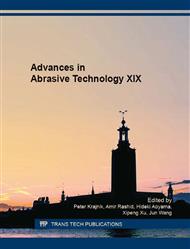p.193
p.199
p.205
p.213
p.219
p.227
p.232
p.241
p.247
Modeling of Kerf Profile Generated in Multi-Layered Laminate Composites with Abrasive Waterjet
Abstract:
Kerf profile generated by abrasive waterjet (AWJ) machining process has always been an interesting area as it dictates the quality of the part. However, due to the non-deterministic nature of the process, it is a challenging task to predict it. On the other hand, understanding and controlling the kerf profile in multi-layered structures (MLSs) is a further difficult task as various layers made of different materials respond to erosion in a different manner and results in a completely different kerf shape (barrel or x-shaped kerf profile) due to the material removal mechanisms dependency on the material property of the specific layers, jet divergence and position of specific layer. Therefore, it is important to understand and develop predictive models of resulting kerf profile in MLSs so that they can be used in controlling the accuracy of the resulting kerf which in turn dictates the final part accuracy. The attempts in this direction are very limited although some modeling efforts are reported in homogeneous materials (metals, ceramics). For the first time, an analytical model for predicting the kerf profile generated in MLS machining with AWJ was presented in this research work. Discretized form of Hashish model was used for determining depth of cut. The effect of jet divergence from the experimentally obtained values, upon passing through the upper layer has been considered. The developed predictive model was validated by the kerf shapes obtained from the experimental trials on metal-adhesive-rubber MLS. Kerf profiles obtained from the simulations have captured the resulted convergent-divergent (X-shaped) profile, while cutting metal-rubber laminate composite, effectively. Furthermore, the effectiveness of the proposed analytical model was demonstrated by generating the various kerf shapes generated at various jet traverse rates.
Info:
Periodical:
Pages:
219-224
Citation:
Online since:
October 2016
Authors:
Price:
Сopyright:
© 2016 Trans Tech Publications Ltd. All Rights Reserved
Share:
Citation:


